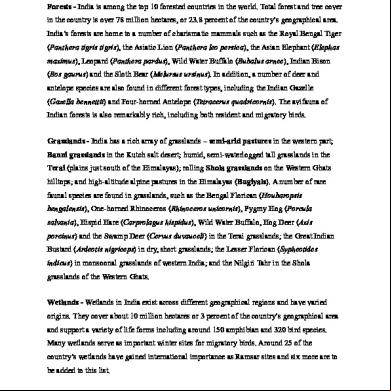Major Habitat Types Of India 6w3j9
This document was ed by and they confirmed that they have the permission to share it. If you are author or own the copyright of this book, please report to us by using this report form. Report 3b7i
Overview 3e4r5l
& View Major Habitat Types Of India as PDF for free.
More details w3441
- Words: 622
- Pages: 2
Major habitat types of India Forests - India is among the top 10 forested countries in the world. Total forest and tree cover in the country is over 78 million hectares, or 23.8 percent of the country’s geographical area. India’s forests are home to a number of charismatic mammals such as the Royal Bengal Tiger (Panthera tigris tigris), the Asiatic Lion (Panthera leo persica), the Asian Elephant (Elephas maximus), Leopard (Panthera pardus), Wild Water Buffalo (Bubalus arnee), Indian Bison (Bos gaurus) and the Sloth Bear (Melursus ursinus). In addition, a number of deer and antelope species are also found in different forest types, including the Indian Gazelle (Gazella bennettii) and Four-horned Antelope (Tetracerus quadricornis). The avifauna of Indian forests is also remarkably rich, including both resident and migratory birds. Grasslands - India has a rich array of grasslands – semi-arid pastures in the western part; Banni grasslands in the Kutch salt desert; humid, semi-waterlogged tall grasslands in the Terai (plains just south of the Himalayas); rolling Shola grasslands on the Western Ghats hilltops; and high-altitude alpine pastures in the Himalayas (Bugiyals). A number of rare faunal species are found in grasslands, such as the Bengal Florican (Houbaropsis bengalensis), One-horned Rhinoceros (Rhinoceros unicornis), Pygmy Hog (Porcula salvania), Hispid Hare (Carprolagus hispidus), Wild Water Buffalo, Hog Deer (Axis porcinus) and the Swamp Deer (Cervus duvauceli) in the Terai grasslands; the Great Indian Bustard (Ardeotis nigriceps) in dry, short grasslands; the Lesser Florican (Sypheotides indicus) in monsoonal grasslands of western India; and the Nilgiri Tahr in the Shola grasslands of the Western Ghats. Wetlands - Wetlands in India exist across different geographical regions and have varied origins. They cover about 10 million hectares or 3 percent of the country’s geographical area and a variety of life forms including around 150 amphibian and 320 bird species. Many wetlands serve as important winter sites for migratory birds. Around 25 of the country’s wetlands have gained international importance as Ramsar sites and six more are to be added to this list. Coral reefs - Indian reef area to contain about 200 coral species belonging to 71 genera spread around 0.24 million hectares. Coral reefs primarily occur in the Andaman and Nicobar
Islands, the Gulf of Kutch, Gulf of Mannar and Lakshadweep. The Andaman and Nicobar Islands alone have 179 coral species. Mangroves - India has some of the finest mangroves in the world, nestled in the alluvial deltas of the Ganga, Mahanadi, Godavari, Krishna, and Cauveri rivers and on the Andaman and Nicobar Islands. Mangrove vegetation is spread over 0.47 million hectares or 0.14 percent of the country’s geographical area. India s for around 3 percent of the world’s mangrove vegetation and almost half of it is located in Sundarbans in West Bengal. The Indian mangroves 105 fish, 20 shellfish and 229 crustacean species. Among a range of avian and mammalian species, a notable inhabitant of mangroves is the Royal Bengal Tiger, which roams the swamps of Sundarbans (UNEP 2001). Deserts - India has both hot (sand and salt) and cold deserts. The Thar desert – seventh largest in the world – is the main hot sand desert. Several species have adopted themselves to survive in the harsh desert conditions. The faunal diversity is also rich, with 755 invertebrate and 440 vertebrate species, including 140 bird and 41 mammalian species and the only known population of the Asiatic Wild Ass (Equus hemionus khur). The cold deserts cover 5.62 percent of the country’s geographical area where the temperature can plummet to as low as -50oC during winters. Cold deserts are also home to many endangered animal species such as Asiatic Ibex (Capra sibrica), Tibetan Argali (Ovis ammon hodgsoni), Wild Yak (Bos mutus) and Snow Leopard (Uncia uncia).
Islands, the Gulf of Kutch, Gulf of Mannar and Lakshadweep. The Andaman and Nicobar Islands alone have 179 coral species. Mangroves - India has some of the finest mangroves in the world, nestled in the alluvial deltas of the Ganga, Mahanadi, Godavari, Krishna, and Cauveri rivers and on the Andaman and Nicobar Islands. Mangrove vegetation is spread over 0.47 million hectares or 0.14 percent of the country’s geographical area. India s for around 3 percent of the world’s mangrove vegetation and almost half of it is located in Sundarbans in West Bengal. The Indian mangroves 105 fish, 20 shellfish and 229 crustacean species. Among a range of avian and mammalian species, a notable inhabitant of mangroves is the Royal Bengal Tiger, which roams the swamps of Sundarbans (UNEP 2001). Deserts - India has both hot (sand and salt) and cold deserts. The Thar desert – seventh largest in the world – is the main hot sand desert. Several species have adopted themselves to survive in the harsh desert conditions. The faunal diversity is also rich, with 755 invertebrate and 440 vertebrate species, including 140 bird and 41 mammalian species and the only known population of the Asiatic Wild Ass (Equus hemionus khur). The cold deserts cover 5.62 percent of the country’s geographical area where the temperature can plummet to as low as -50oC during winters. Cold deserts are also home to many endangered animal species such as Asiatic Ibex (Capra sibrica), Tibetan Argali (Ovis ammon hodgsoni), Wild Yak (Bos mutus) and Snow Leopard (Uncia uncia).





